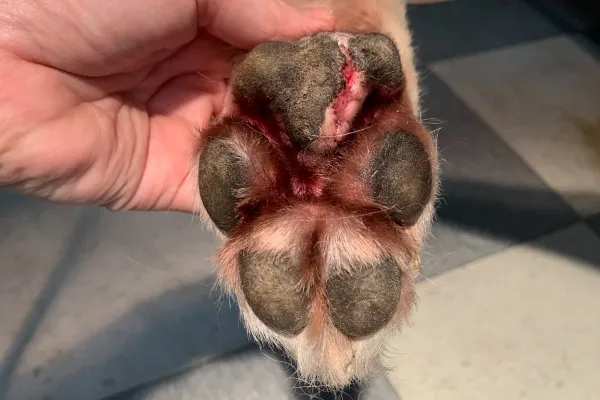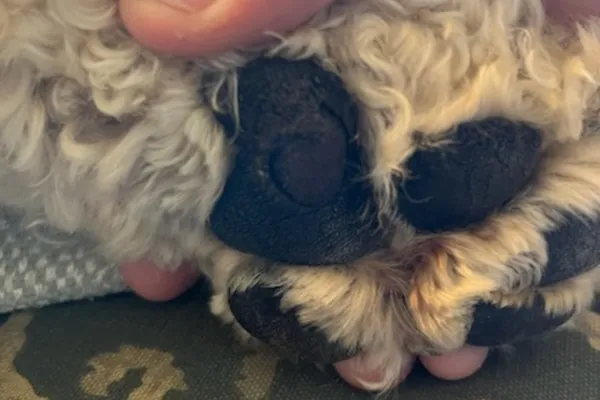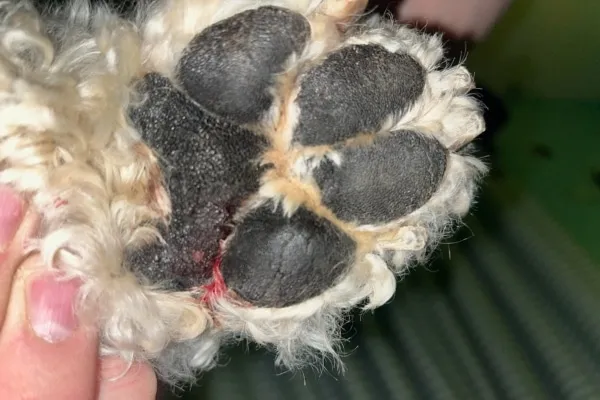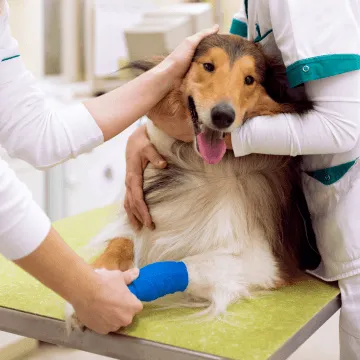A dog paw pad injury can range from minor scrapes to severe burns and punctures. Knowing how to respond when your dog injures a paw pad is crucial for their comfort and recovery. As a veterinarian, I’ve seen my fair share of paw pad injuries, and I want to share my expertise to guide you through the process of providing first aid and seeking professional veterinary care when needed.
The Importance of Dog Paw Pads
Our dogs rely heavily on their paws for mobility and overall well-being. The paws’ intricate network of muscles, bones, tendons, and ligaments enable them to walk, run, and play. Healthy paw pads are essential for comfortable and secure movement, providing support, cushioning, and protection.
 Close up of a dog
Close up of a dog
Paw pads offer cushioning and support, reducing strain on the joints.
These thick, squishy pads act as shock absorbers, minimizing stress on the bones and joints with each step. They also work with the toenails to provide traction, allowing your dog to navigate various terrains with ease. Additionally, paw pads offer protection from extreme temperatures, shielding your dog’s feet from hot pavement and icy surfaces. For a deeper dive into canine paw anatomy, I recommend exploring resources detailing the structure and function of dog paws.
Common Types of Paw Pad Injuries
Due to their constant contact with the ground, paw pads are vulnerable to various injuries. Here are some common types of paw pad injuries I frequently encounter:
Foreign Objects
Sharp objects like broken glass, foxtails, nails, or splinters can easily puncture a dog’s paw pad. These foreign bodies can cause pain, inflammation, and potential infection. Prompt removal and proper wound care are essential to prevent complications.
Cuts and Lacerations
Cuts are another common paw pad injury, often resulting from sharp objects slicing the pad. These cuts can range from superficial to deep, requiring different levels of treatment. Sometimes, dry paw pads can crack and split open, leading to non-traumatic cuts.
Paw Pad Flaps
Paw pad flaps are similar to cuts but involve a larger surface area, typically running parallel to the pad’s surface. These flaps often occur when a dog’s foot is sliced horizontally, creating a loose flap of skin. Untreated cuts can also develop into flaps over time. Flaps are generally more painful than simple cuts, as each step pulls on the loose skin and irritates the area.
 Dog pad with a section of a flap removed
Dog pad with a section of a flap removed
This dog had a paw pad flap removed, revealing healed tissue underneath.
Burns
Paw pad burns are common, particularly during the summer months when pavement temperatures soar. Hot asphalt, concrete, and artificial turf can cause severe burns on a dog’s paw pads. Extremely cold temperatures and ice melt products can also lead to burns, dryness, and cracking. Chemical burns can occur from contact with spilled caustic substances.
Ingrown Toenails
Overgrown toenails can curl inward and penetrate the paw pad, causing pain and potential infection. This is why regular nail trimming is essential for dog paw health. Ingrown toenails can be extremely painful and may require veterinary intervention.
Recognizing a Paw Pad Injury
If your dog experiences a paw pad injury, you may notice several signs, including:
- Sudden limping or lameness
- Crying out when putting weight on the affected paw
- Reluctance to put pressure on the paw
- Bleeding from the paw pad
- Excessive licking or biting at the paw
- Swelling of the foot
- Discoloration or redness of the paw pad
- Visible cut, flap, puncture, or foreign object
- Discoloration of the hair on the foot
If you observe any of these symptoms, carefully inspect your dog’s paw to determine the type and severity of the injury.
First Aid for Paw Pad Injuries
Knowing how to administer first aid for paw pad injuries is essential for providing immediate relief and preventing further complications. Here’s a step-by-step guide:
- Evaluate Your Dog: Start by comforting your dog and assessing their overall condition. If your dog is in severe pain or unwilling to let you examine the paw, seek immediate veterinary care.
- Inspect the Paw: Carefully examine the top and bottom of the paw, the pads themselves, and the areas between the toes. Determine if there is a cut, flap, puncture wound, burn, or foreign object.
- Remove Foreign Objects (If Safe): If a small, superficial object is embedded in the paw pad, you may be able to remove it with tweezers. However, if the object is deeply lodged or potentially puncturing a blood vessel, nerve, or joint, do not attempt to remove it yourself. Seek immediate veterinary attention.
- Control Bleeding: If the wound is bleeding, apply direct pressure with a clean cloth or paper towel. Minor wounds should stop bleeding within a few minutes. If the bleeding persists for more than 10-15 minutes, contact your veterinarian immediately.
- Clean the Wound: Once the bleeding has stopped, gently clean the wound with cool water. You can also use mild antibacterial soap or a diluted antiseptic solution like chlorhexidine or betadine.
- Apply a Bandage: To protect the wound from further injury and contamination, apply a bandage. Use clean materials like gauze and vet wrap. Be sure to wrap the paw properly, ensuring that the bandage is not too tight. A bandage that is too tight can cut off circulation and cause further complications. You can find detailed instructions on how to wrap paw pads on a dog.
 Dog paw pad with some bleeding seen
Dog paw pad with some bleeding seen
Carefully inspect each paw if your dog shows signs of injury.
Even after providing first aid, contacting your veterinarian is crucial to determine if further treatment is necessary.
Veterinary Evaluation and Treatment
During a veterinary appointment, the veterinarian will perform a thorough physical examination to assess your dog’s overall health and the extent of the paw pad injury. They may palpate and manipulate the foot to check for any underlying issues.
If a foreign object is suspected deep within the foot, an X-ray may be recommended to determine its location and involvement with bones or joints.
Treatment for a paw pad injury may involve trimming the hair around the affected area for better visualization and cleaning. The veterinarian will then clean the wound and remove any debris or foreign objects.
While sutures are commonly used for deep cuts, they are often avoided on paw pads due to the high friction and movement in this area. Instead, bandaging is often the preferred method for promoting healing.
Antibacterial ointments or soothing creams may be applied to the wound before bandaging. The bandage serves several purposes, including controlling bleeding, preventing re-injury, keeping the wound clean, containing medication, and discouraging licking or chewing. An E-collar may also be necessary to prevent your dog from interfering with the healing process.
Follow your veterinarian’s instructions carefully regarding bandage changes, medication administration, and recheck appointments.
Promoting Healing and Preventing Complications
Paw pad injuries can take time to heal due to the constant use of the feet. It’s essential to be patient and follow your veterinarian’s instructions closely. Contact your veterinarian if you suspect the injury isn’t healing properly.
One of the most common complications with paw pad injuries is a bandage that is too tight. Ensure you can insert one to two fingers into the top of the bandage to prevent circulation issues. Watch for signs of swelling, discoloration, or coolness in the toes.
Preventing Future Paw Pad Injuries
While some injuries are unavoidable, several precautions can help prevent paw pad problems:
- Avoid Extreme Temperatures: Protect your dog’s paws from hot pavement and icy surfaces. Walk your dog during cooler times of the day and avoid hot sidewalks. If it’s too hot for you to hold the back of your hand against the pavement for 7-10 seconds, it’s too hot for your dog’s paws.
- Use Protective Booties: Consider using dog booties like PawZ to shield your dog’s paws from extreme temperatures, ice melt products, and rough terrain. Remove the booties indoors to prevent circulation problems.
- Wash Feet After Walks: After winter walks, wash your dog’s feet to remove ice melt products and other chemicals.
- Inspect Feet Regularly: Examine your dog’s feet for foxtails, debris, and any signs of injury after each outing.
- Trim Nails Regularly: Keep your dog’s nails trimmed to prevent them from growing into the paw pads.
- Be Aware of Surroundings: Keep an eye out for hazards along the path or trail, such as broken glass, sharp rocks, and other debris.
Preparedness is Key
In addition to these prevention strategies, being prepared for potential injuries is essential. Create a dog first aid kit for your home and car, including bandages, antiseptic solution, gauze pads, and tweezers.
 Veterinarian examining a dog
Veterinarian examining a dog
Your veterinarian may need to trim hair to fully examine the injury.
While I hope your dog never experiences a paw pad injury, knowing how to provide first aid and when to seek veterinary care will help ensure a speedy recovery. Remember, you can provide first aid to your dog, but when in doubt, contact your veterinarian for advice. They can help you manage your dog’s pad injury so that your pup can be back to playing in no time! If you’re looking for further information, consider searching for how to treat a dogs raw paw pad or how to treat a scraped paw pad.
